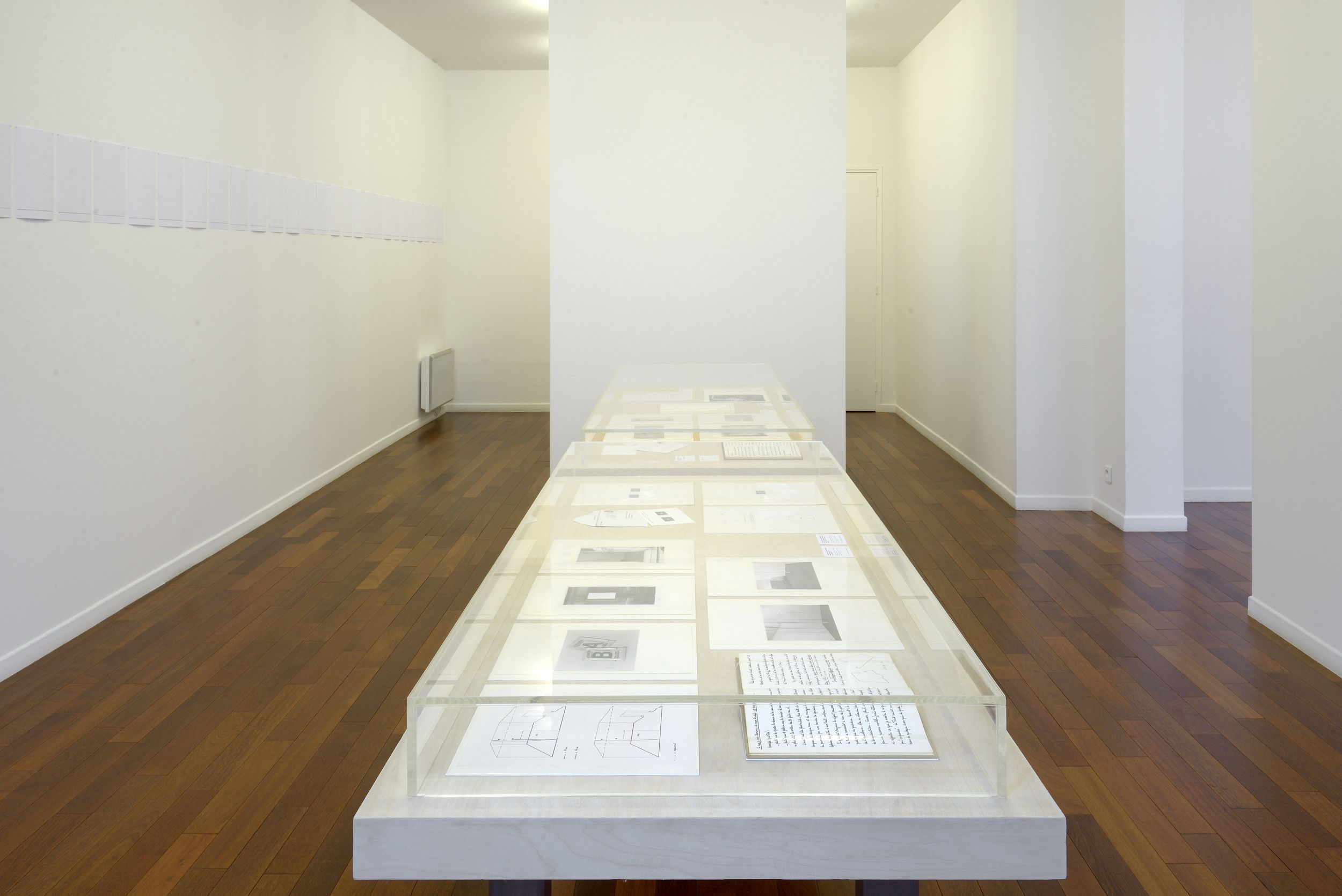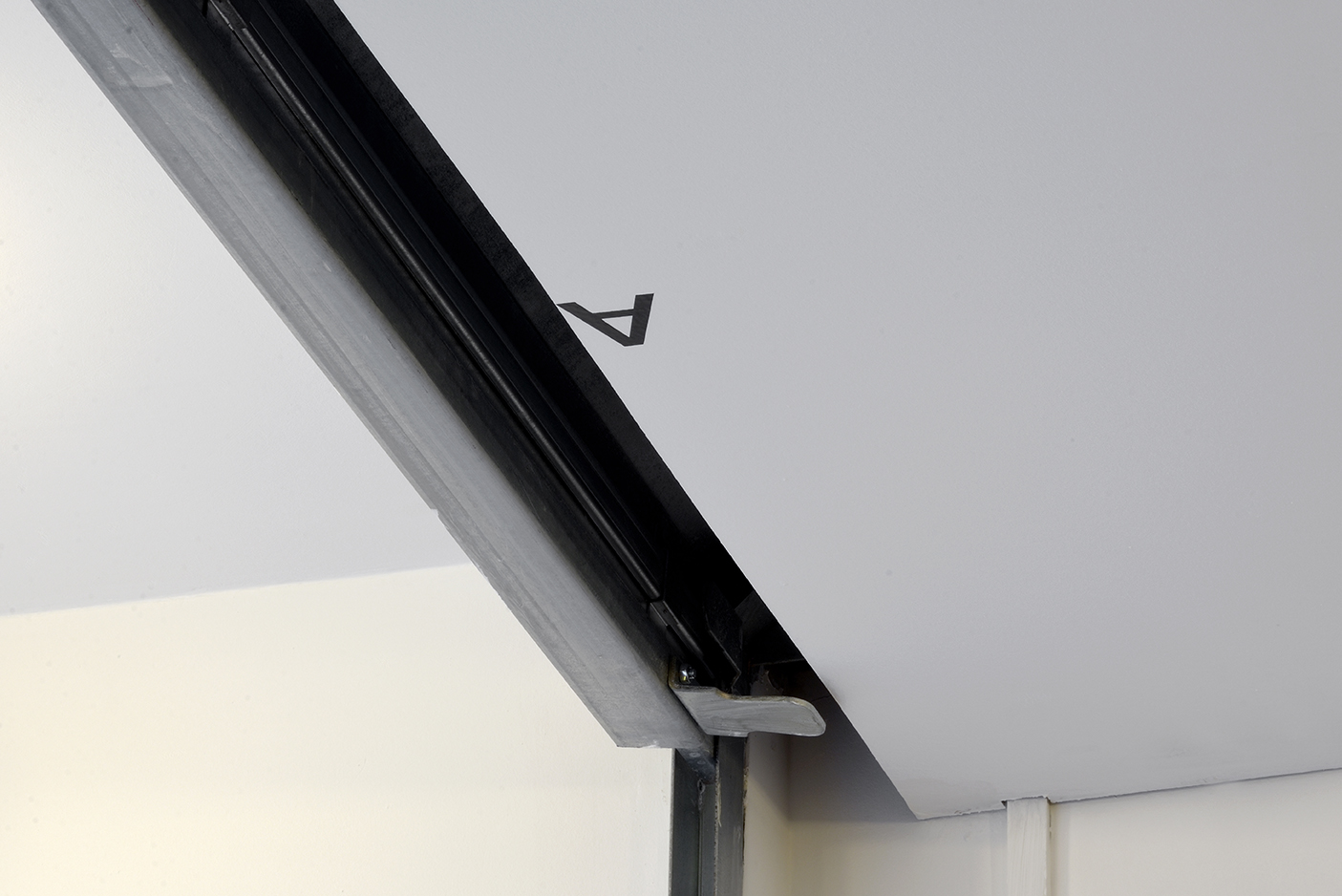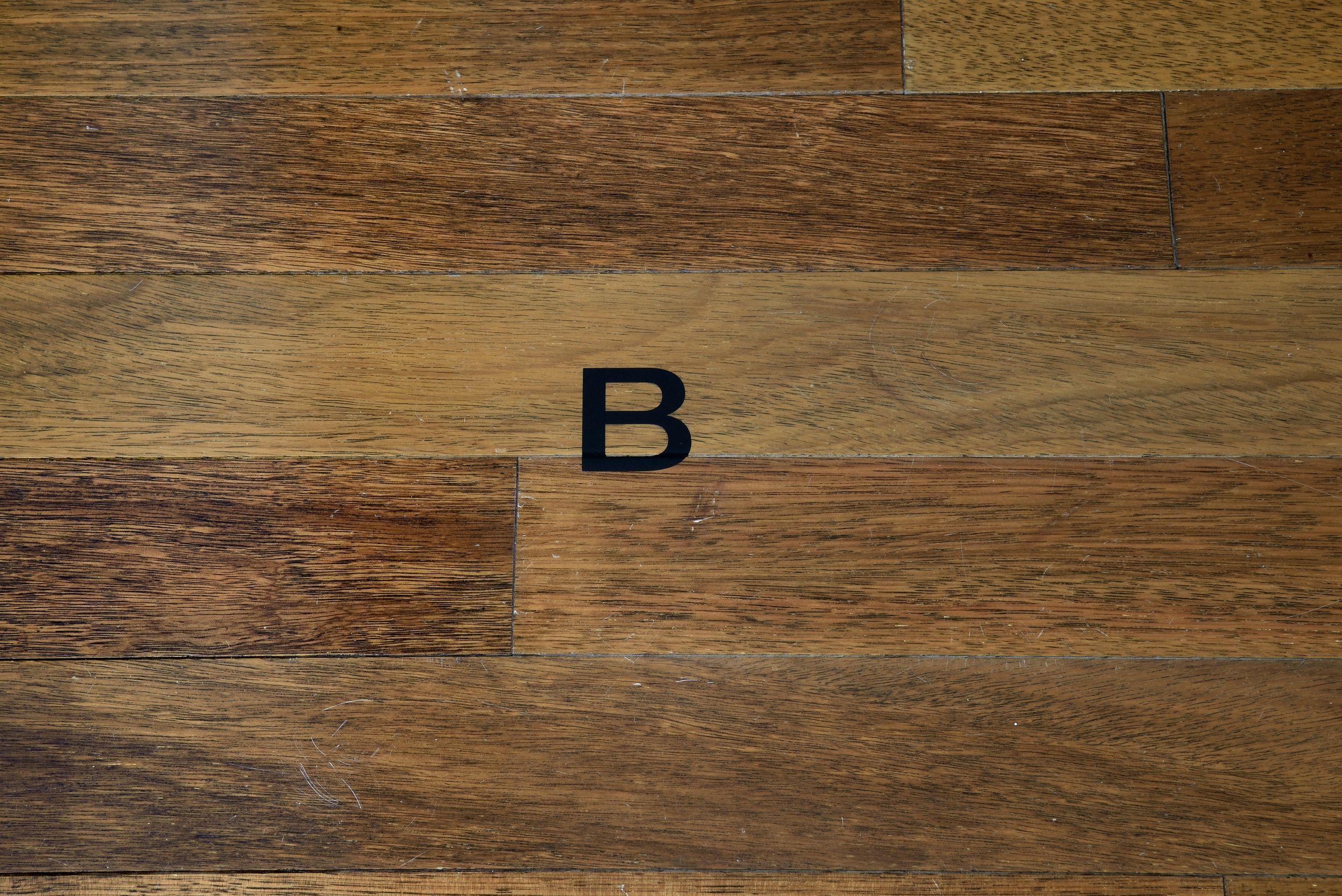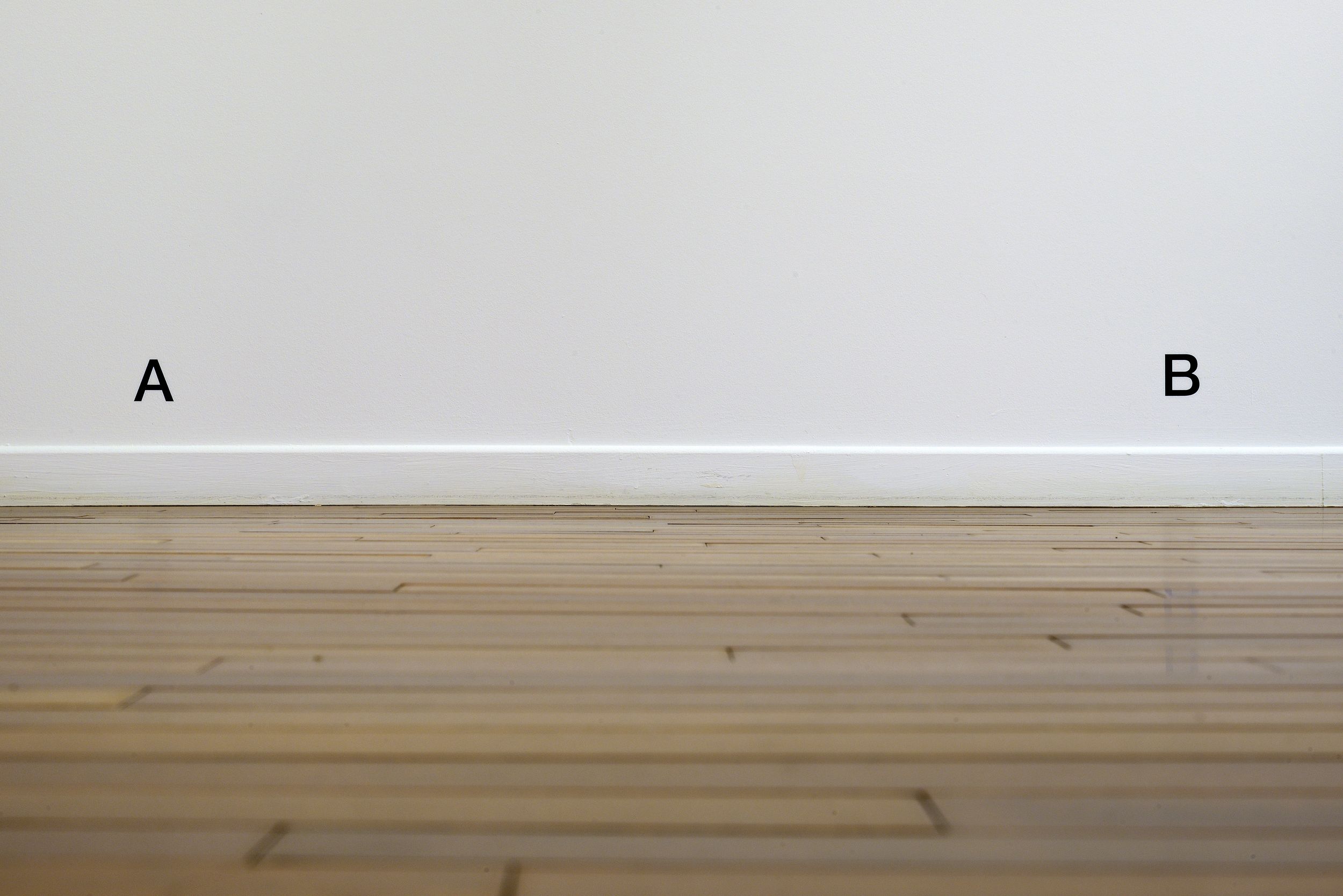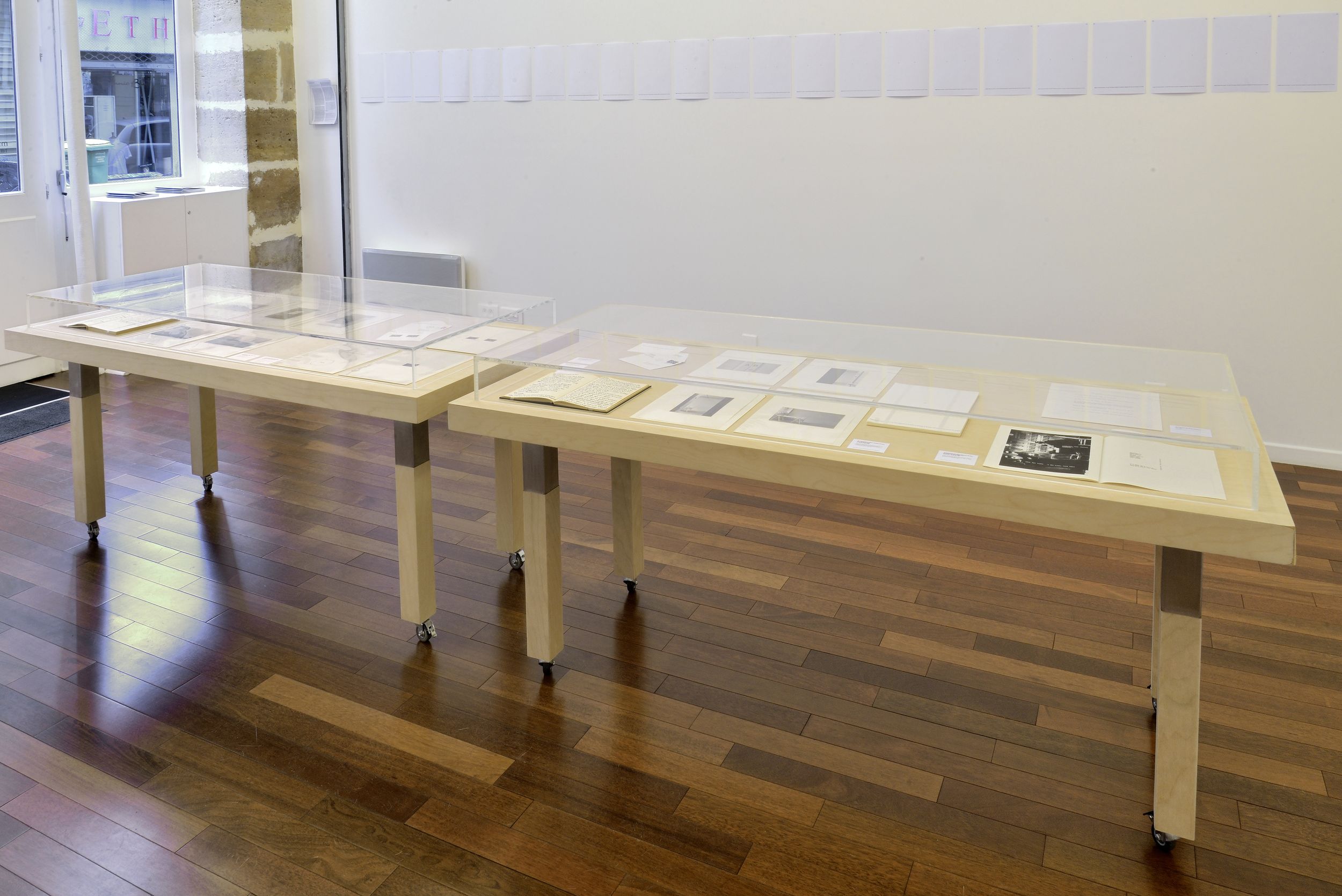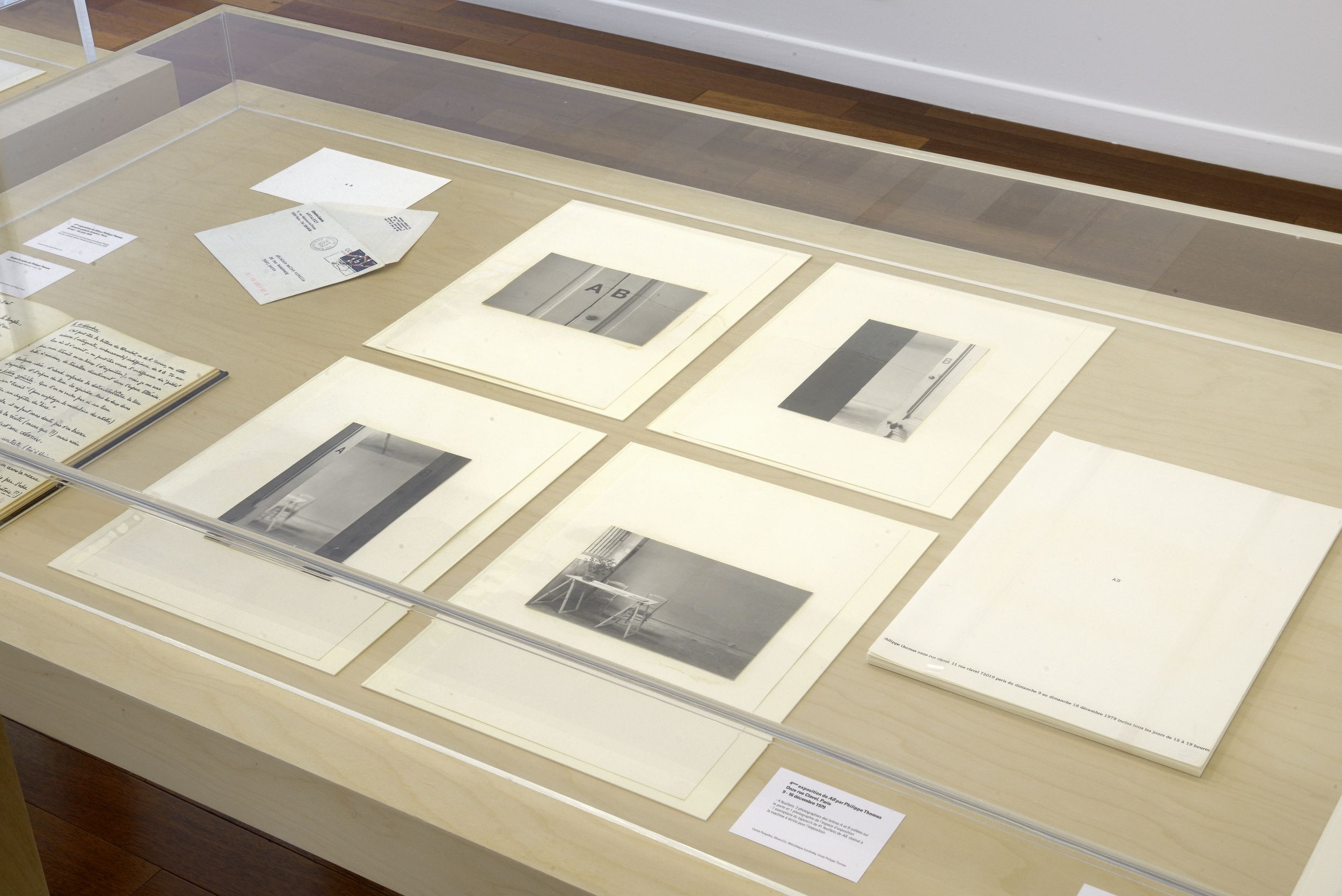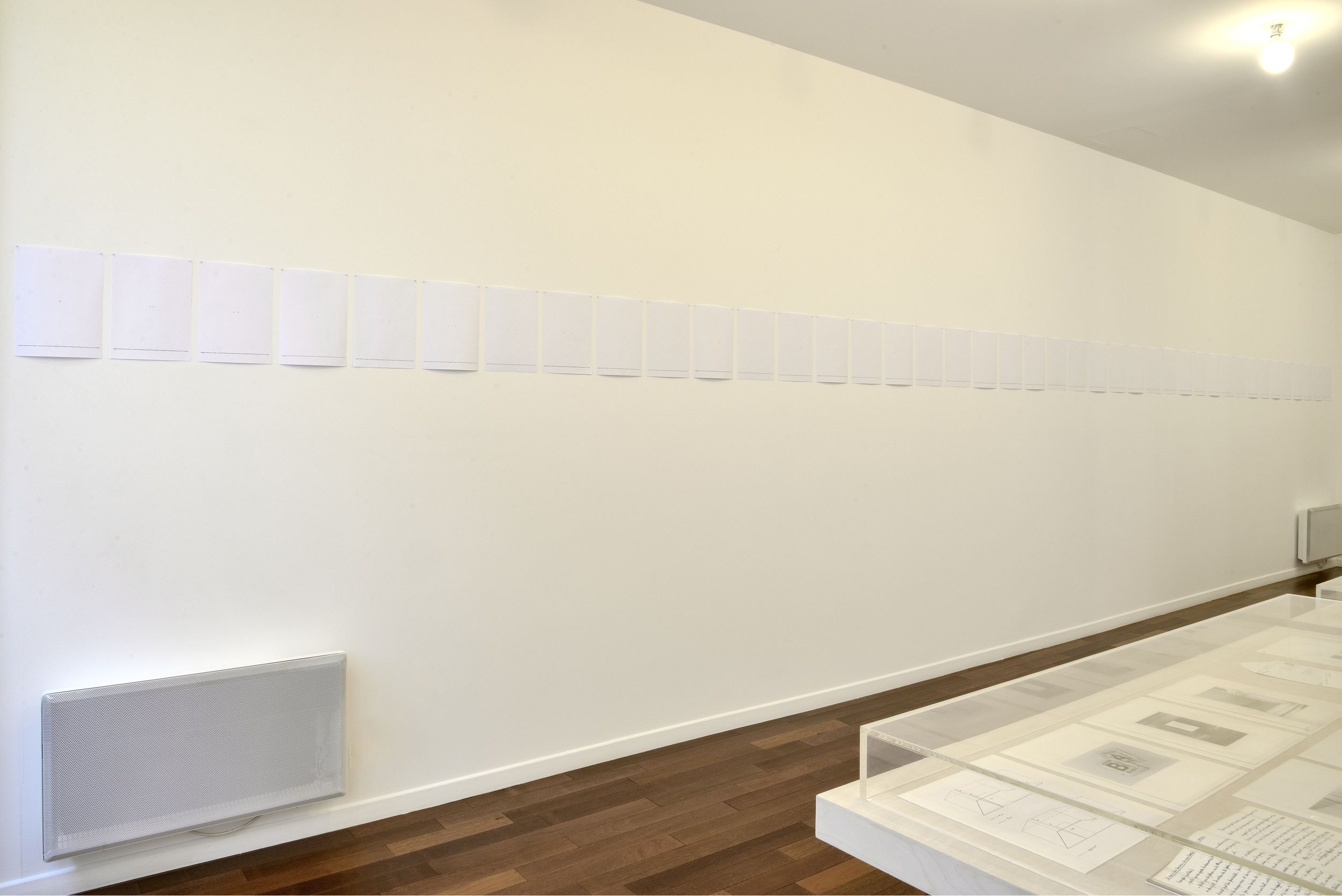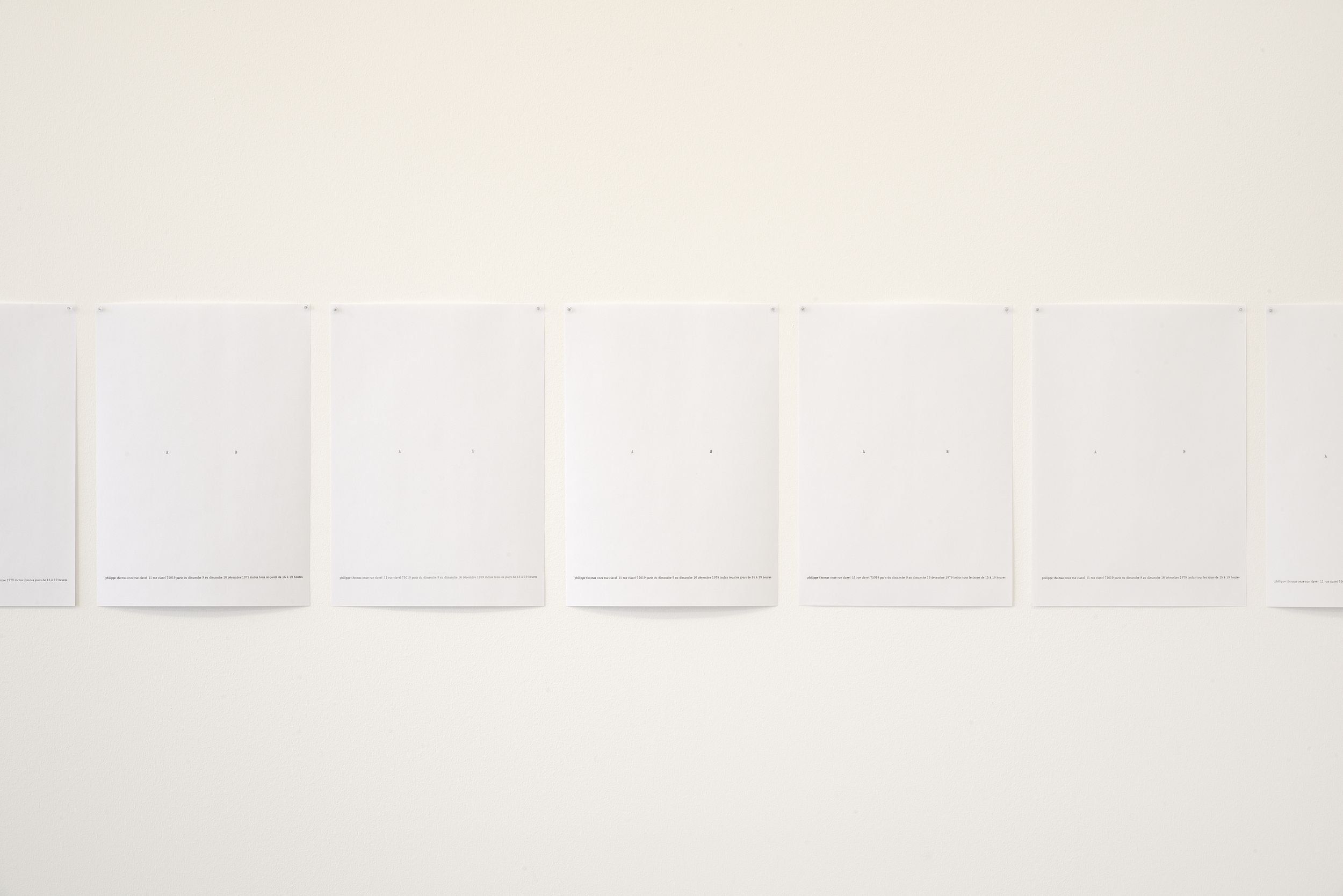AB (1978-1980) - Exhibitionmfc-michèle didier | Paris - Brussels - PARIS
From Tuesday April 29 to Saturday May 31, 2014
Opening on April 28, 2014 from 6pm to 9pm in presence of the curator
An exhibition curated by Émeline Jaret
Knowing the kind of issues Philippe Thomas’ early work deals with, it seemed only natural to present Philippe Thomas’ work at mfc-michèle didier gallery. AB is a multifaceted body of work and two of its productions will be presented during the exhibition Philippe Thomas: AB (1978-1980).
- A reconstitution of the very first production displayed in 1978 during the Mixage International in Caen, a device made up of various elements: a couple of letters A and B materialised in black vinyl letraset identical to the letters inscribed on the invitation which is also part of the exhibition.
- The tapuscript AB, consisting of 41 sheets of A4 sized paper will line the walls of the gallery.
To complete the AB artwork, a selection of unreleased documents from the Fonds Philippe Thomas conserved at the Kandinsky Library (Pompidou Centre, Paris) will also be presented: photographs, drawings, invitations, as well as two of the artist’s sketchbooks.
The exhibition Philippe Thomas: AB (1978-1980) is curated by Émeline Jaret and aims to cast a new light on the more mysterious period of the artist’s life. A PhD student in Art History, Émeline Jaret began to write a monographic thesis on Philippe Thomas’ work in 2011 supervised by Arnauld Pierre of Paris-Sorbonne University (Paris IV). She has worked as an assistant to Claire Burrus for the inheritance proceedings of Philippe Thomas and undertook the necessary steps for the Fonds Philippe Thomas to enter the Kandinsky Library. She has written for an issue of the magazine Retour d’y voir dedicated to the artist in 2012. In 2013, Émeline Jaret was nominated for the “Art History” scholarship at the Centre Pompidou, Paris.
mfc-michèle didier would like to thank especially Claire Burrus, Philippe Thomas’ testamentary executor, for her support in organizing the exhibition Philippe Thomas: AB (1978-1980). The gallery is also grateful to the Kandinsky Library of Centre Pompidou for taking part in the project and making it happen. Lastly, mfc-michèle didier would like to thank Ghislain Mollet-Viéville for generously lending us two rare documents from his personal collection.
Jan Mot (Brussels) represents the works of Philippe Thomas since October 2012.
AB: A first glance
The years from 1977 to 1980 were of the experimental kind for Philippe Thomas who, coming from a literary background, experiments with various artistic practices, all edging towards the same issue. In the first years of his career, his work can be roughly divided into two groups. Working with paper and typewriting, Philippe Thomas focused on the material aspect of signs from which he experiments with the relationship between the surface (of the page) and its inherent constraints. The works also take part in redefining the act of reading, since the absence of punctuation and syntactical chaos helps generate new meaning through differently combined letters. These early works include the use of objects somewhere in between sculpture and painting, made using large strips of surgical tape. These pieces also tackle the notion of spacing (no longer between letters but between the strips of surgical tape), opening a new and fundamental dimension for the works that follow, a dimension which reunites the object with the space it is presented in. These two types of work thus question (among other things) their connection to the surface in which they are inscribed and tend to break away from such a link. Evolving amidst many artists’ groups from 1977 to 1980, Philippe Thomas decides, in March 1985, to go his own way and leaves the IFP group he had founded with Dominique Pasqualini and Jean François Brun. He then elaborates his body of work, in line with his early researches and examining issues which are fundamental to twentieth-century art, to be crystallised as he creates the agency readymades belong to everyone® in 1987, in New York.
Some of these themes already underly the AB display. Placed on the threshold between being seen and being read, it is a display that stems from the early works by Philippe Thomas, a multifaceted and evolving artwork which claims as many different appearances as the number of surfaces on which it is inscribed. Six exhibitions between December 1978 and June 1980 give consistency to the project: Mixage International (Caen) in December 1978, at Ghislain Mollet-Viéville’s (Paris) in March 1979 and in June 1980, at the bookshop-gallery Artalect (Paris) in May 1979, at Onze rue Clavel (Paris) in December 1979 and at 12, Waffelaerts Straat (Bruxelles) in January and February 1980. Each one of them adds a new element to help AB evolve. During the first exhibition, AB is presented as a set of letrasets (letters in adhesive vinyl) and corresponds to a geometrical convention which, on dropping the strips of surgical tape linking the letters A and B, takes on a linguistic dimension. The display is deconstructed as layers of paint illustrate the interactions between different appearances of AB during the second exhibition which takes place outdoors three months later. From as soon as the third AB exhibition on, the letter B is given the possibility to move around, breaking from the former geometrical convention of a straight line between A and B. AB is no longer limited to a specific spot but is seen all over the place, embracing the entire exhibition space including its “accidents” (interacting with the viewer). Henceforth, AB is indifferent to its allotted place and to the nature of the space around it, for what matters is its sole presence. This new direction is confirmed by the other exhibitions that follow, especially at Onze rue Clavel, where AB appears also on paper.
AB defines itself as a display composed of heterogenous elements, multiplying both the surfaces from which it tends to overflow and its various appearances: letraset, painting, photography, typewritten texts, etc. In allowing the play of interaction between the letters to show, it also incorporates various spatiotemporal data. Such elements serve the purpose of questioning the space surrounding a piece of art, a place for and by which the artwork is created. In the same way AB is not simply an installation on the wall but interacts with the surrounding space, each component of AB and the ties between them have to be taken into consideration as a whole. Then, Philippe Thomas’ creative context emerges in these questionings and AB is a witness to the artist’s maturing habit of identifying himself with “models” in order to find his place in a certain art scene. Philippe Thomas is as influenced, at that time, by sources such as the writings of Derrida, Heidegger, Blanchot, Russell or Goodman, as by the works of fellow artists (the likes of Niele Toroni, Peter Downsborough, Claude Rutault, as well as Daniel Buren and Joseph Kosuth) and discussions he has with them.
AB is a pivotal work through which Philippe Thomas breaks free of his previous work, and through which he casts a new light upon the transitional value that the questions he deals with have in the development of his body of work. The Texte Théorique (1980-1981) which comes before the manuscrit trouvé (1981), was originally an attempt to write a introductory text for AB.AB finds thus its lineage in the manuscrit trouvé, typescript of seven pages, which establish, through their content and manner of presentation, the theoretical foundation of the artist’s project. For this, AB is the missing link for understanding the chronological coherence of Philippe Thomas’ work.
Émeline Jaret3
1 Mixage International is a centre for alternative art founded and run by Joël Hubaut in Caen, between 1978 and 1985.
2 Claude Rutault, who lives at the time at 11 rue Clavel (Paris, 19th arrondissement), provides a studio that the artists in his entourage can use for various exhibitions and events.
3 Excerpt from an article to be published: Émeline Jaret, “Les dispositifs à l’œuvre chez Philippe Thomas = l’exemple de AB (1978-1980)”, in Marges, n°20, Presses universitaires de Vincennes (Vincennes University Press), Spring 2015
Round Table
The reception context of Philippe Thomas’ works: letting the artists be heard
Thursday May 15, 2014 from 6 pm to 8 pm
WITH:
Rémi Parcolet and Aurélien Mole, scomparo, Sébastien Rémy, Ludovic Chemarin© (lectures by Isabelle de Maison Rouge, Damien Beguet and P. Nicolas Ledoux)
Normally, mfc-michèle didier only collaborates with living artists. The interactions between the editor and the artist that take place in the course of a series of meetings are fundamental and embody the essence of a publisher’s work.This is why, along with Émeline Jaret, the curator of the exhibition Philippe Thomas: AB (1978-1980), mfc-michèle didier has decided to let the contemporary artists whose works are in progress talk.
The roundtable was punctuated by 4 successive interventions, each of which casted a new light on Philippe Thomas’ work by the singular way of thinking presented by the participant. The speakers discussed subjects such as fiction, mass, conference-performance, the name of the artist and his signature and the photography of exhibitions, each according to their field of experience.
From Tuesday April 29 to Saturday May 31, 2014
Opening on April 28, 2014 from 6pm to 9pm in presence of the curator
An exhibition curated by Émeline Jaret
Knowing the kind of issues Philippe Thomas’ early work deals with, it seemed only natural to present Philippe Thomas’ work at mfc-michèle didier gallery. AB is a multifaceted body of work and two of its productions will be presented during the exhibition Philippe Thomas: AB (1978-1980).
- A reconstitution of the very first production displayed in 1978 during the Mixage International in Caen, a device made up of various elements: a couple of letters A and B materialised in black vinyl letraset identical to the letters inscribed on the invitation which is also part of the exhibition.
- The tapuscript AB, consisting of 41 sheets of A4 sized paper will line the walls of the gallery.
To complete the AB artwork, a selection of unreleased documents from the Fonds Philippe Thomas conserved at the Kandinsky Library (Pompidou Centre, Paris) will also be presented: photographs, drawings, invitations, as well as two of the artist’s sketchbooks.
The exhibition Philippe Thomas: AB (1978-1980) is curated by Émeline Jaret and aims to cast a new light on the more mysterious period of the artist’s life. A PhD student in Art History, Émeline Jaret began to write a monographic thesis on Philippe Thomas’ work in 2011 supervised by Arnauld Pierre of Paris-Sorbonne University (Paris IV). She has worked as an assistant to Claire Burrus for the inheritance proceedings of Philippe Thomas and undertook the necessary steps for the Fonds Philippe Thomas to enter the Kandinsky Library. She has written for an issue of the magazine Retour d’y voir dedicated to the artist in 2012. In 2013, Émeline Jaret was nominated for the “Art History” scholarship at the Centre Pompidou, Paris.
mfc-michèle didier would like to thank especially Claire Burrus, Philippe Thomas’ testamentary executor, for her support in organizing the exhibition Philippe Thomas: AB (1978-1980). The gallery is also grateful to the Kandinsky Library of Centre Pompidou for taking part in the project and making it happen. Lastly, mfc-michèle didier would like to thank Ghislain Mollet-Viéville for generously lending us two rare documents from his personal collection.
Jan Mot (Brussels) represents the works of Philippe Thomas since October 2012.
AB: A first glance
The years from 1977 to 1980 were of the experimental kind for Philippe Thomas who, coming from a literary background, experiments with various artistic practices, all edging towards the same issue. In the first years of his career, his work can be roughly divided into two groups. Working with paper and typewriting, Philippe Thomas focused on the material aspect of signs from which he experiments with the relationship between the surface (of the page) and its inherent constraints. The works also take part in redefining the act of reading, since the absence of punctuation and syntactical chaos helps generate new meaning through differently combined letters. These early works include the use of objects somewhere in between sculpture and painting, made using large strips of surgical tape. These pieces also tackle the notion of spacing (no longer between letters but between the strips of surgical tape), opening a new and fundamental dimension for the works that follow, a dimension which reunites the object with the space it is presented in. These two types of work thus question (among other things) their connection to the surface in which they are inscribed and tend to break away from such a link. Evolving amidst many artists’ groups from 1977 to 1980, Philippe Thomas decides, in March 1985, to go his own way and leaves the IFP group he had founded with Dominique Pasqualini and Jean François Brun. He then elaborates his body of work, in line with his early researches and examining issues which are fundamental to twentieth-century art, to be crystallised as he creates the agency readymades belong to everyone® in 1987, in New York.
Some of these themes already underly the AB display. Placed on the threshold between being seen and being read, it is a display that stems from the early works by Philippe Thomas, a multifaceted and evolving artwork which claims as many different appearances as the number of surfaces on which it is inscribed. Six exhibitions between December 1978 and June 1980 give consistency to the project: Mixage International (Caen) in December 1978, at Ghislain Mollet-Viéville’s (Paris) in March 1979 and in June 1980, at the bookshop-gallery Artalect (Paris) in May 1979, at Onze rue Clavel (Paris) in December 1979 and at 12, Waffelaerts Straat (Bruxelles) in January and February 1980. Each one of them adds a new element to help AB evolve. During the first exhibition, AB is presented as a set of letrasets (letters in adhesive vinyl) and corresponds to a geometrical convention which, on dropping the strips of surgical tape linking the letters A and B, takes on a linguistic dimension. The display is deconstructed as layers of paint illustrate the interactions between different appearances of AB during the second exhibition which takes place outdoors three months later. From as soon as the third AB exhibition on, the letter B is given the possibility to move around, breaking from the former geometrical convention of a straight line between A and B. AB is no longer limited to a specific spot but is seen all over the place, embracing the entire exhibition space including its “accidents” (interacting with the viewer). Henceforth, AB is indifferent to its allotted place and to the nature of the space around it, for what matters is its sole presence. This new direction is confirmed by the other exhibitions that follow, especially at Onze rue Clavel, where AB appears also on paper.
AB defines itself as a display composed of heterogenous elements, multiplying both the surfaces from which it tends to overflow and its various appearances: letraset, painting, photography, typewritten texts, etc. In allowing the play of interaction between the letters to show, it also incorporates various spatiotemporal data. Such elements serve the purpose of questioning the space surrounding a piece of art, a place for and by which the artwork is created. In the same way AB is not simply an installation on the wall but interacts with the surrounding space, each component of AB and the ties between them have to be taken into consideration as a whole. Then, Philippe Thomas’ creative context emerges in these questionings and AB is a witness to the artist’s maturing habit of identifying himself with “models” in order to find his place in a certain art scene. Philippe Thomas is as influenced, at that time, by sources such as the writings of Derrida, Heidegger, Blanchot, Russell or Goodman, as by the works of fellow artists (the likes of Niele Toroni, Peter Downsborough, Claude Rutault, as well as Daniel Buren and Joseph Kosuth) and discussions he has with them.
AB is a pivotal work through which Philippe Thomas breaks free of his previous work, and through which he casts a new light upon the transitional value that the questions he deals with have in the development of his body of work. The Texte Théorique (1980-1981) which comes before the manuscrit trouvé (1981), was originally an attempt to write a introductory text for AB.AB finds thus its lineage in the manuscrit trouvé, typescript of seven pages, which establish, through their content and manner of presentation, the theoretical foundation of the artist’s project. For this, AB is the missing link for understanding the chronological coherence of Philippe Thomas’ work.
Émeline Jaret3
1 Mixage International is a centre for alternative art founded and run by Joël Hubaut in Caen, between 1978 and 1985.
2 Claude Rutault, who lives at the time at 11 rue Clavel (Paris, 19th arrondissement), provides a studio that the artists in his entourage can use for various exhibitions and events.
3 Excerpt from an article to be published: Émeline Jaret, “Les dispositifs à l’œuvre chez Philippe Thomas = l’exemple de AB (1978-1980)”, in Marges, n°20, Presses universitaires de Vincennes (Vincennes University Press), Spring 2015
Round Table
The reception context of Philippe Thomas’ works: letting the artists be heard
Thursday May 15, 2014 from 6 pm to 8 pm
WITH:
Rémi Parcolet and Aurélien Mole, scomparo, Sébastien Rémy, Ludovic Chemarin© (lectures by Isabelle de Maison Rouge, Damien Beguet and P. Nicolas Ledoux)
Normally, mfc-michèle didier only collaborates with living artists. The interactions between the editor and the artist that take place in the course of a series of meetings are fundamental and embody the essence of a publisher’s work.This is why, along with Émeline Jaret, the curator of the exhibition Philippe Thomas: AB (1978-1980), mfc-michèle didier has decided to let the contemporary artists whose works are in progress talk.
The roundtable was punctuated by 4 successive interventions, each of which casted a new light on Philippe Thomas’ work by the singular way of thinking presented by the participant. The speakers discussed subjects such as fiction, mass, conference-performance, the name of the artist and his signature and the photography of exhibitions, each according to their field of experience.
